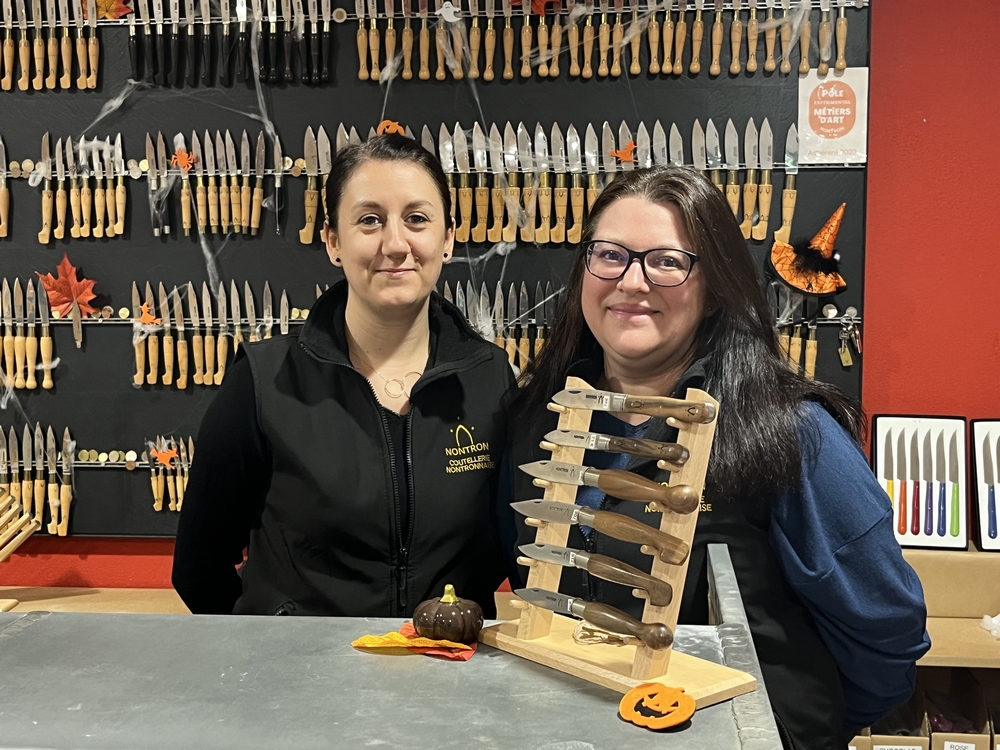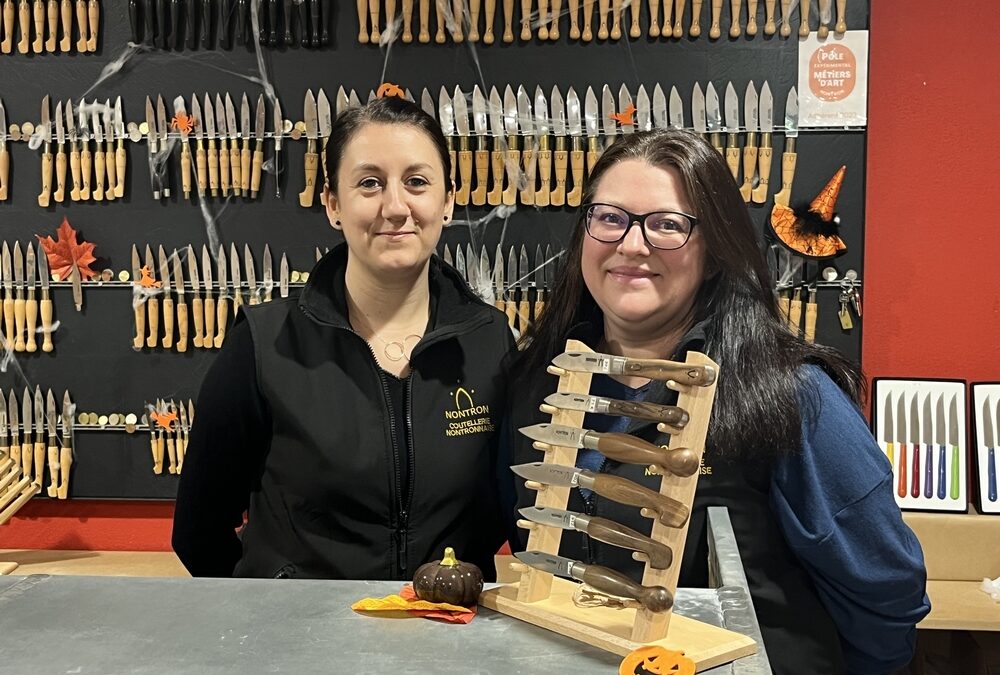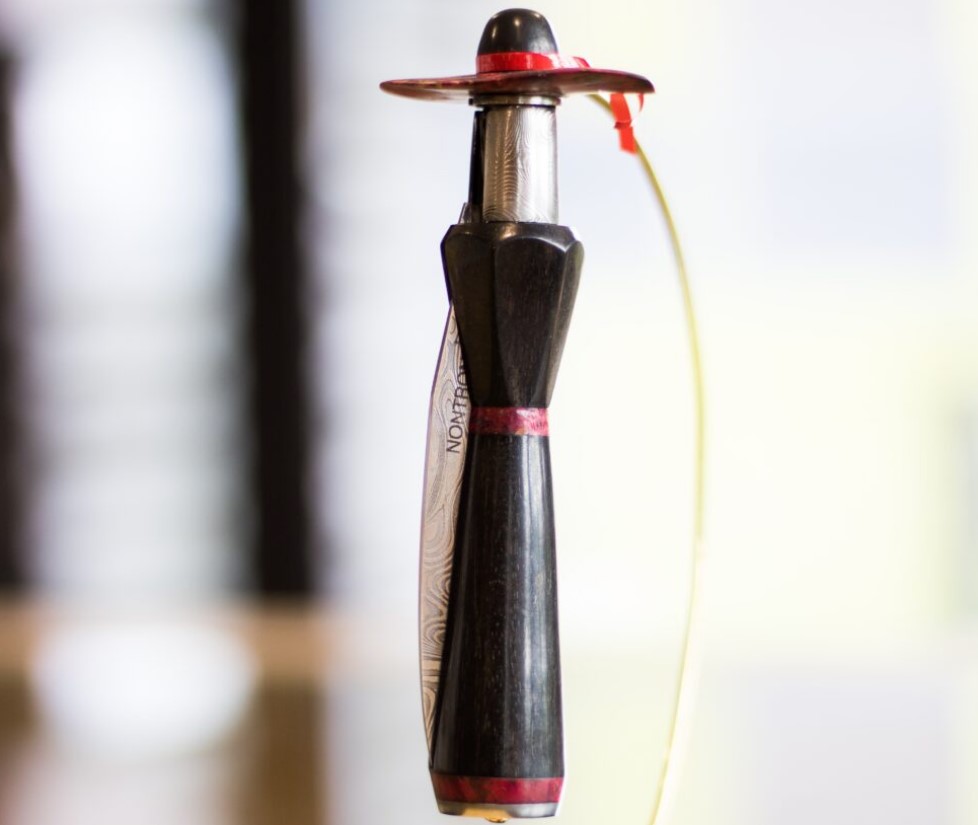Amélie Boucaud and Noémie Brachet are multi-skilled sales assistants in La Coutellerie Nontronnaise workshop boutique, Place Paul Bert in Nontron. They talk about their jobs, their favourite knives, the Nontron knife and of course … La Coutellerie Nontronnaise
Noémie, how long have you been working at La Coutellerie Nontronnaise?
I joined La Coutellerie Nontronnaise in 2006 as a trainee sales-assistant under the supervision of Stéphanie and Claudine. They were the ones who guided me through my apprenticeship. They introduced me to the products and the values the Nontron knife represents. I come from a “nontronnaise “family, so my grandfather always had a pair of paring knives and a folding knife in his pocket. He used it to cut salads, but for meals also, as did my great-grandmother; the Nontron knife had already been in my life for a long time.
And you, Amélie?
In 2010. I was already familiar with La Coutellerie Nontronnaise, having done my traineeship as a secretary-accountant when I left school. My grandparents were farmers, my grandfather always had a Nontron folding knife in his pocket for meals, for everything, and I went to school in Nontron. So, when I was offered the chance to join La Coutellerie Nontronnaise, I didn’t ask myself any questions; it was a natural choice for me.
What are your earliest memories?
Amélie: The smell of wood, that’s my first memory.
Noémie : Me too, it’s the smell of wood and the display where all the knives are placed.
Amélie: Oh yes, that’s right, there was also the display case at the entrance.
You’re both multi-skilled sales assistants in the Atelier boutique, what does that involve?
We look after sales on the website, online sales, packaging, orders, dispatch, and quality control. We check the wood of the handle, the stability of the ferrule, etc.
We also carry out pyrography on the handles and engraving on the blades. What’s more, we’re very close to the workshop. It’s a really varied job, but Stéphanie has trained us well in sales, which is above all based on a very good knowledge of our knives.
How do you go about it, and what are your customers’ requirements?
Pyrography is a technique for engraving handles by burning them. We generally work on light-coloured woods, but we can also engrave darker woods such as walnut handles. We are mainly asked to inscribe initials.
On the blade, it is mostly names, first names, a grandfather coming to have his grandson’s first name engraved… Blade engraving requires a blade that is at least eight centimetres long.
Noémie: We also engrave bread knife blades. Sometimes there are more specific requests, phrases, like “Love always…”.
I remember a customer who wanted his telephone number engraved on the blade. He said, “If I lose it, someone will bring it back to me” (smiles).
Amélie: I remember another anecdote. One day, I saw a lady come in who’d had lunch in a restaurant called “La Table de Pavie”, which uses our knives.
She had kept an extraordinary memory of it and asked me to engrave “La Table de Martine” on the blade of the ebony TD knives she had just bought. It was her first name (smiles).
Have you noticed a seasonal pattern in these requests?
Of course, we have! There are two strong periods: Christmas and Valentine’s Day in February. Summer is also a busy time.
And what about visitors, can you give us an idea of the distribution?
It’s essentially a local clientele or French holidaymakers. Foreigners are less interested in this type of service. Americans and English come mainly for our tableware knives. We recently had two American couples visit us. The two wives each bought a box of six sky-blue knives with acrylic handles to match their two dining rooms, which were both blue.
What are, and remain, your biggest challenges?
The computerisation of all data and stocks. We had to adapt. The organisation of the stands is also always an important occasion because it allows us to showcase our techniques and the expertise of La Coutellerie Nontronnaise. So, it’s important that the stand looks good and is well laid out.
What has been your greatest source of pride?
Participating in the design and manufacture of the MAMZ’ELLE knife, which will be entered in the cutlery competition at the Fête du couteau in 2021. We were fully integrated to the team, taking part at every stage, right through to production. We were able to add to our experience and gain a real understanding of the knife. What’s more, the MAMZ’ELLE was a celebration of women! It’s one of our fondest memories.
What are your favourite knives?
Amélie: The classic No. 22 ball folding knife, which I find very pretty, or the Office knives, which I also use at home.
Noémie: The boxwood lock blade knife. I always have one in my pocket or my bag, it’s a knife with a history. I’m also very fond of Office knives.
Do you each have a particular area of responsibility? How do you divide up the work?
No, we don’t have a specific job because we’re very versatile. We don’t share the work! We do it together with our third colleague, Sandrine.
Noémie: Actually, we’re a bit more than three colleagues, which makes communication easier. (smiles)
Amélie: Sandrine and Noémie were my two-marriage witness. (smiles).
What does working for La Coutellerie Nontronnaise means to you?
Working for La Coutellerie Nontronnaise means being able to pass on our regional heritage, show it off, evoke the skills of our colleagues and showcase some very fine objects, so it’s a privilege.







